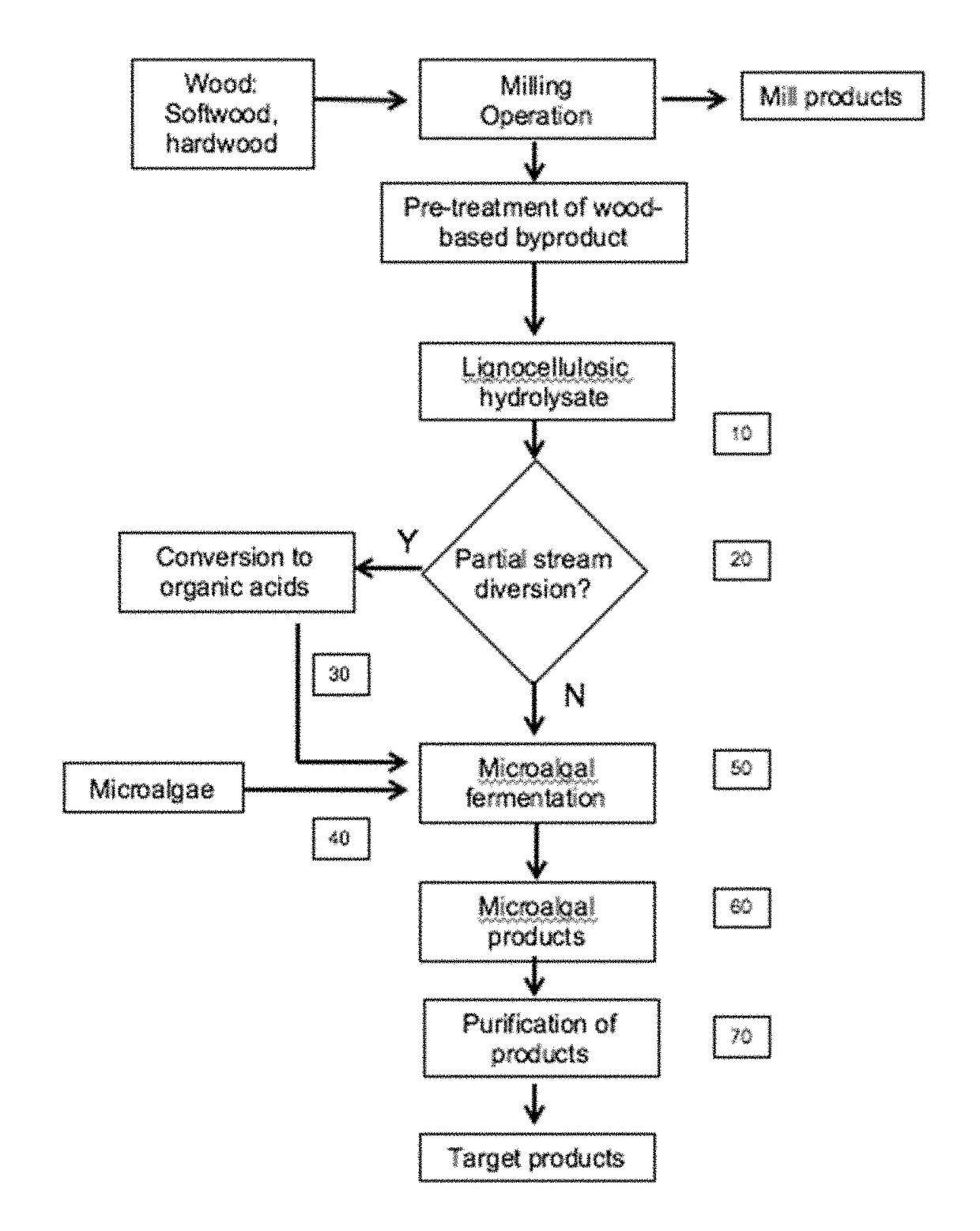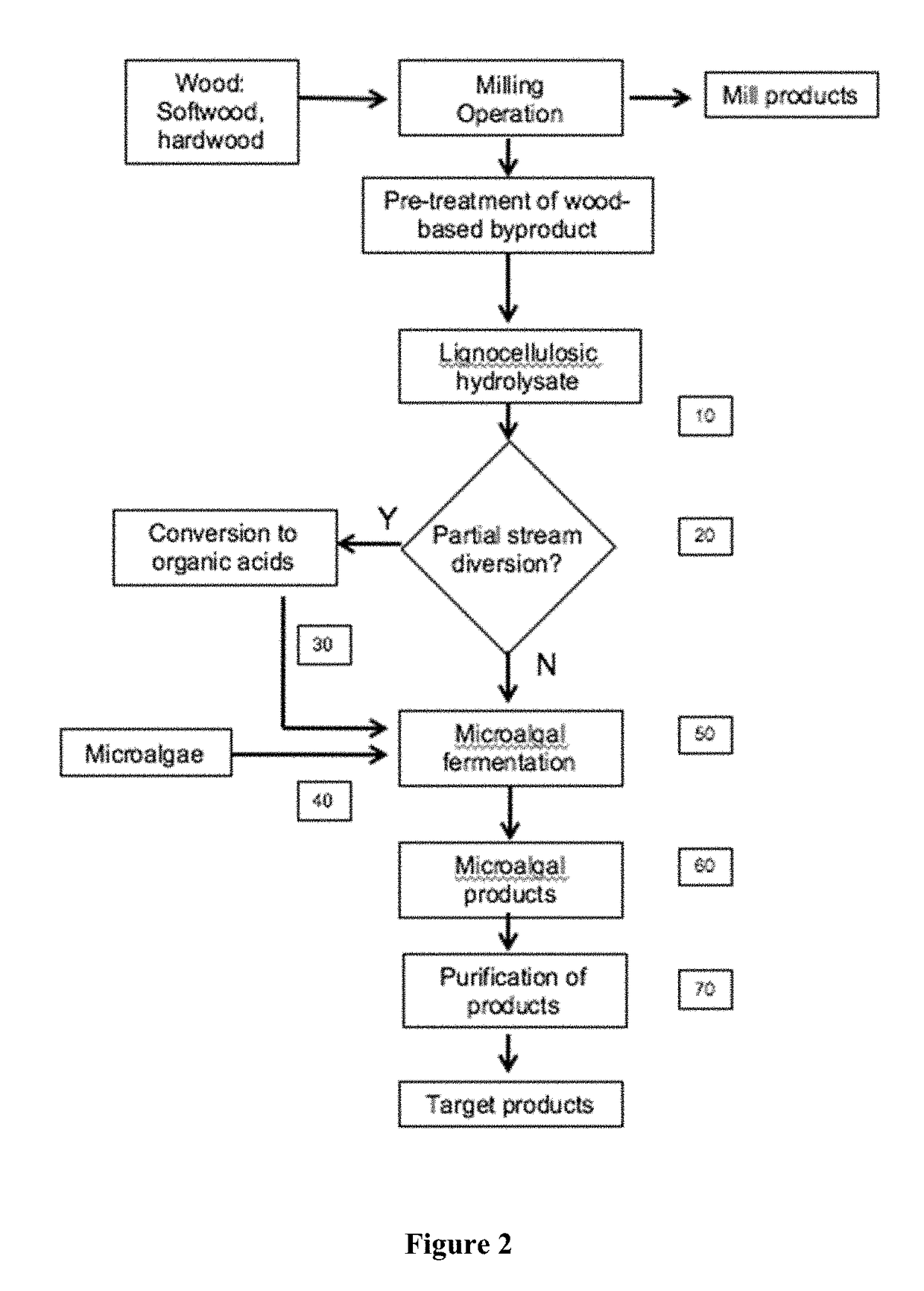Producing and altering microbial fermentation products using non-commonly used lignocellulosic hydrolysates
- Summary
- Abstract
- Description
- Claims
- Application Information
AI Technical Summary
Benefits of technology
Problems solved by technology
Method used
Image
Examples
example 1
Wood Hydrolysate from Pulp and Paper Mill Material, Microbial Species and Fermentation Conditions
[0184]Enzymatic hydrolysates of various compositions are produced courtesy of Cellulose Sciences International (Madison, Wis.) and Domtar International according to U.S. Pat. No. 8,617,851 from various woody biomass, supplied by Domtar International, subjected to alkali plus co-solvent pre-treatment (Table 5). The enzymes product, used according to manufacturer's direction, was Cellic Ctec2 (Novozymes) that is a blend of cellulases, beta-glucosidases, and hemicellulase. Incubation was 72 hours with agitation, 50° C., solids loading of 2%, followed by filtration through a 10 kD filter to remove the enzymes. Lignocellulosic hydrolysates (FIG. 2, [10]) from softwood and hardwood were prepared and analyzed. The algae strains selected for testing are based on their potential biomass applications for biofuels (lipids), feed (whole biomass, protein and lipids), and specialty products (colorants...
example 2
Biomass Production on Wood Hydrolysates
[0192]Multiwell plates are used as an initial screening tool to determine the capability of microalgal cultures to grow in the dark on wood hydrolysates from pine softwood, southern hardwoods and northern hardwoods. Surprisingly, all wood enzymatic hydrolysates tested support growth and biomass production of microalgae, though performance varies with each type of hydrolysate. For example, the three wood hydrolysates designated SHC, SPBK, and SPFC (Table 5), standardized to 18 g / L total sugars, show different growth profiles for Chlorella KAS908, with one hydrolysate (SPFC) being inhibitory for the first four days (FIG. 3). During this period, culture using SPFC in the dark shows nominal growth (OD750 between 0 and 0.1) similar to the negative control in the dark using F / 2 with yeast extract and no added sugars or hydrolysate (OD750 between 0 and 0.1), while the growth of positive controls on 9 g / L glucose and 18 g / L glucose reaches OD750 above ...
example 3
Biomass Product, Some Extractives, and Sugar Conversion Efficiency Using Wood Hydrolysates
[0197]This example demonstrates higher biomass productivities on wood hydrolysate than on model sugars and higher than expected efficiency of bioconversion. Growth of Chlorella KAS908 in a medium based on softwood hydrolysate, Bleached Southern Pine (BSP with 2F+1.8 g / L YE) hydrolysate, is compared to that in a medium containing an equivalent mixture of C5 and C6 model sugars (16.34 g / L glucose and 1.66 g / L xylose) using a 7-L dark stirred fermentor. Surprisingly, the wood hydrolysate with monosaccharides and process residuals outperform the model sugars alone, with a 1.6-fold (160%) higher biomass productivity of 2.87 g / L / day compared to 1.7 g / L / day for the control Chlorella. KAS908 utilizes the glucose and xylose in series during dark fermentation, as shown by a decrease and eventual complete depletion of both sugars in the culture medium containing wood hydrolysates (FIG. 6a), a feature mimi...
PUM
| Property | Measurement | Unit |
|---|---|---|
| Fraction | aaaaa | aaaaa |
| Fraction | aaaaa | aaaaa |
| Fraction | aaaaa | aaaaa |
Abstract
Description
Claims
Application Information
 Login to View More
Login to View More - R&D
- Intellectual Property
- Life Sciences
- Materials
- Tech Scout
- Unparalleled Data Quality
- Higher Quality Content
- 60% Fewer Hallucinations
Browse by: Latest US Patents, China's latest patents, Technical Efficacy Thesaurus, Application Domain, Technology Topic, Popular Technical Reports.
© 2025 PatSnap. All rights reserved.Legal|Privacy policy|Modern Slavery Act Transparency Statement|Sitemap|About US| Contact US: help@patsnap.com



